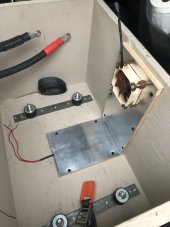Two winters later . . .
Last year did not go so well. really low temps (-15 cel) and the watts the heating pad through out was not enough to keep up. Fortunately the BMS did and I switched to the lead carbon bank to maintain the heaters below zero. Seems to be the only way as the BMS shuts off the discharge power below zero, so no juice for the heating pad. I have played with a number of settings but he real kicker is to keep the snow off the panels or everything shuts down. Also I have about 50 watts of heat go into the aluminum on the bottom of the batteries but that draws constant when it is really cold. The best solution I can find here in Colorado is to keep the lead carbon bank on, LiFePO4 bank off and let the LC bank keep the Lithium bank from freezing. They are enclosed with some insulation but when the trailer is not heated and the wind blows outside, it is really hard to keep the Lithium warm enough to stay over zero. This year I check every week and the problem seems to have not gone away. At the end of the day it is about balance between your solar array and the power to keep the lithium bank warm enough.




